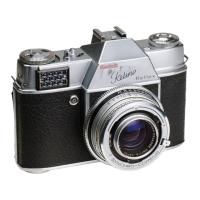The mirror and capping plate are also linked to the transport mechanism. This is operated by a rapid winding
lever. In addition to advancing the film, the rapid winding lever closes the capping plate, brings down the mirror
into the viewing position, advances the film counter, and tensions and opens the shutter for viewing.
The film transport acts directly on the sprocket which pulls the film through the camera, and is also linked to the
friction-driven take-up spool.
Two types of lens system are available. On the Retina Reflex III, IV and S the whole lens is mounted
interchangeably in front of the shutter. Each lens has an automatic depth of field indicator.
On the earlier Retina Reflex the front unit is interchangeable and can be changed for a wide-angle or telephoto
unit, while the rear component is firmly mounted behind the shutter blades.
The shutter is a Synchro-Compur with coupled aperture and speed settings. It is MX-synchronized with built-in
self-timer; the synchronizing lever can only be adjusted after releasing a safety lock.
A photo-electric exposure meter is built into the body at the right-hand (transport) end of the camera. A
diffusing disc is available to fit over the cell for incident light readings.
The camera back is hinged at one end; a special safety device prevents accidental opening. The pressure plate
does not press the film directly against the track, but leaves a very thin channel for the film.
The Retina Reflex will accept most of the accessories made for the Retina IIS to IIIC cameras. The lenses of the
Retina Reflex III, IV and S are interchangeable with the Retina III S lenses; those of the earlier Reflex are
interchangeable with Retina IIC to IIIC lens units.
THE WINDING AND RELEASE SEQUENCE
Working the rapid winding lever gets the camera ready for the next exposure. The operations taking place are :
1. The film and film counter advance to the next frame;
2. The capping plate comes down to protect the film against the light;
3. The mirror swings down into position for viewing;
4. The lens diaphragm opens up to it's maximum aperture;
5. The shutter is tensioned and opens for viewing and focusing.
In fact, some of these functions take place more or less simultaneously.
On pressing the release button a number of operations take place immediately preceding the actual exposure.

